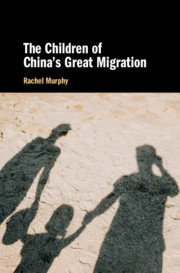Book contents
- The Children of China’s Great Migration
- The Children of China’s Great Migration
- Copyright page
- Contents
- Figures and Maps
- Tables
- Acknowledgements
- 1 Understanding the Lives of Left-Behind Children in Rural China
- 2 Migration, Education and Family Striving in Four Counties of Anhui and Jiangxi
- 3 Sacrifice and Study
- 4 Boys’ and Girls’ Experiences of Distribution in Striving Families
- 5 Children in ‘Mother At-Home, Father Out’ Families
- 6 Children of Lone-Migrant Mothers and At-Home Fathers
- 7 Children in Skipped Generation Families
- 8 Left-Behind Children in Striving Teams
- Appendix: Field Research on Left-Behind Children in China
- Bibliography
- Index
4 - Boys’ and Girls’ Experiences of Distribution in Striving Families
Published online by Cambridge University Press: 06 August 2020
- The Children of China’s Great Migration
- The Children of China’s Great Migration
- Copyright page
- Contents
- Figures and Maps
- Tables
- Acknowledgements
- 1 Understanding the Lives of Left-Behind Children in Rural China
- 2 Migration, Education and Family Striving in Four Counties of Anhui and Jiangxi
- 3 Sacrifice and Study
- 4 Boys’ and Girls’ Experiences of Distribution in Striving Families
- 5 Children in ‘Mother At-Home, Father Out’ Families
- 6 Children of Lone-Migrant Mothers and At-Home Fathers
- 7 Children in Skipped Generation Families
- 8 Left-Behind Children in Striving Teams
- Appendix: Field Research on Left-Behind Children in China
- Bibliography
- Index
Summary
Chapter 4 explores the distribution of resources and chores to children by their gender and their perceptions of their family’s distributional practices when their parents had migrated. Chiefly, parents felt obligated to provide sons with money for education and housing, but they only felt obligated to support their daughters’ education.Children realised that their gender impacted on what their parents aimed to provide for them. At the same time, many children perceived inequality in the adults’ everyday treatment of them vis-à-vis their opposite-gender sibling, for instance, in the distribution of food and treats, access to the television remote control, and household chores. Gender inequalities were sometimes also discerned by children in their parents’ decisions about which sibling stayed behind in the countryside and which sibling migrated with the parents. Nevertheless, gender equality in child-raising practices were also evident, including in investment in children’s education and even in the amount of pocket money boys and girls received, as well as in the children’s receipt of gifts from migrant parents. But even as left-behind children benefited from wider processes favouring gender equality, the effects unfolded unevenly across localities, families, and individuals such that boys’ and girls’ experiences of being left-behind varied.
- Type
- Chapter
- Information
- The Children of China's Great Migration , pp. 95 - 131Publisher: Cambridge University PressPrint publication year: 2020



